Distribution Characteristics and Ecological Risk Assessment of Heavy Metals in Marine Sediments of Binhai County, Jiangsu Province
Abstract
:1. Introduction
2. Materials and Methods
2.1. Study area Overview
2.2. Sample Collection and Processing
2.3. Main Methods
2.3.1. Heavy Metal Pollution Assessments
- Geoaccumulation index
- Potential ecological risk assessment
2.3.2. Multivariate Statistical Analysis
3. Results
3.1. Statistical Results of Heavy Metal Content in Sediments
3.2. Assessment of Heavy Metal Pollution
3.2.1. Geoaccumulation Index
3.2.2. Potential Ecological Risk Index
3.3. Analysis of Heavy Metal Sources and Changes Based on Multivariate Statistics
3.3.1. Correlation Analysis
3.3.2. Cluster Analysis
3.3.3. Spatial Variation of Heavy Metals in Sediments
4. Discussion
4.1. Influencing Factors of Heavy Metal Content and Spatial Distribution
4.2. Heavy Metal Source Analysis
5. Conclusions
- (1)
- The spatial distribution of the seven heavy metals was uneven. The average contents of the Pb, As, Zn, Cd, and Cu over the years exceeded the background values of the Jiangsu coastal waters. The heavy metal contents in the marine sediments in 2015 were lower than that in the other two years.
- (2)
- The geoaccumulation index assessment showed that the Hg and Cr pollution was very low, with both heavy metals considered to have a clean grade. Cu, Zn, and As had a clean grade to mild pollution. The geoaccumulation index of Cd displayed a significant increasing trend, indicating moderate pollution. The pollution degree of Pb decreased to mild-to-moderate pollution.
- (3)
- The evaluation results of the potential ecological risk index showed that the average value of the index in the 3 years were at a moderate level with an upward trend. The main contributors to the ecological risk were the Cd and Hg in this area. The areas with higher ecological risks are estuaries, ports, and outer waters. The difference was that the contents of the Hg and other heavy metals decreased or remained the same in the three sets of monitoring data, while the Cd increased significantly. The overall ecological risk of the study area was high in 2018.
- (4)
- The Cr in the marine sediments of the study area mainly originated from natural sources, while the other elements were influenced by human activities. In general, the heavy metal pollution of the sediments in the estuaries, ports, and the outer sea area between the Zhongshan estuary and the abandoned Yellow River estuary was relatively serious, mainly affected by the inlet rivers, offshore sewage discharge, port construction, and wind electricity construction activities.
Author Contributions
Funding
Institutional Review Board Statement
Informed Consent Statement
Data Availability Statement
Conflicts of Interest
References
- Shen, F.; Mao, L.J.; Deng, X.Q.; Sun, C.L.; Zhu, Z.R.; Ding, M. Reanalysis of distribution characteristics and contamination evaluation of heavy metals in coastal sediments of Jiangsu province. J. Cap. Norm. Univ. Nat. Sci. Ed. 2018, 39, 62–71. [Google Scholar]
- Sheng, W.K.; Hou, Q.Y.; Yang, Z.F.; Yu, T.; Yuan, J.X.; Dai, G.L.; Tang, Z.M. Distribution characteristics and ecological risk assessment of heavy metals in sediments from Xiang River. China Environ. Sci. 2019, 39, 2230–2240. [Google Scholar]
- Song, H.; Liu, J.; Yin, P.; Zhang, Y. Distribution, enrichment and source of heavy metals in Rizhao offshore area, southeast Shandong Province. Mar. Pollut. Bull. 2017, 119, 175–180. [Google Scholar] [CrossRef]
- Jia, L.; Liu, W.T.; Tang, D.H.; Cai, P.J.; Cui, Z.A. Distribution characteristics and ecological risk assessment of heavy metals in surface sediments in Sanya Bay and surrounding waters. Mar. Geol. Front. 2020, 36, 22–31. [Google Scholar]
- Duan, Y.Y.; Pei, S.F.; Liao, M.W.; Zhai, S.K.; Zhang, H.B.; Xu, G.; Yuan, H.M. Spatial distribution of heavy metals in the surface sediments of Laizhou Bay and their sources and pollution assessment. Mar. Geol. Quat. Geol. 2021, 41, 67–81. [Google Scholar]
- Hu, J. East China Normal University Coastal Evolution Process and Nearshore Suspended Sediment Research of the Abandoned Yellow River Delta. M. D. Thesis, East China Normal University, Shanghai, China, 2014. [Google Scholar]
- Gu, Y. Heavy metal fractionation and ecological risk implications in the intertidal surface sediments of Zhelin Bay, South China. Mar. Pollut. Bull. 2018, 129, 905–912. [Google Scholar] [CrossRef]
- Qiu, J.; Liu, J.; Li, M.; Wang, S.; Bai, W.; Zhang, D. Assessment of heavy metal contamination in surface sediments from the nearshore zone, southern Jiangsu Province, China. Mar. Pollut. Bull. 2018, 133, 281–288. [Google Scholar] [CrossRef]
- Wang, J.; Zhang, Y.M.; Xu, M.; Liu, B.Q. Heavy metal pollution of surface sediments in the northern waters of the abandoned yellow river delta in Jiangsu Province of China and ecological risk assessment. Appl. Ecol. Environ. Res. 2019, 17, 14867–14882. [Google Scholar] [CrossRef]
- Lv, J.S. The environmental geochemistry of heavy metals in soils and sediments in typical regions of Jiangsu coastal zone, Eastern China. M. D. Thesis, Nanjing University, Nanjing, China, 2015. [Google Scholar]
- Muller, G. Index of geoaccumulation in sediments of the Rhine River. Geojournal. 1969, 2(3), 108–118. [Google Scholar]
- Chen, B.B.; Hu, R.Q.; Chen, M.D. Natural background values of environmental elements in coastal soil in Jiangsu. J. Nanjing Agric. Univ. 1985, 8, 54–60. [Google Scholar]
- Hakanson, L. An ecological risk index for aquatic pollution control. A sedimentological approach. Water Res. 1980, 14, 975–1001. [Google Scholar] [CrossRef]
- Chen, B.; Liu, J.; Qiu, J.; Zhang, X.; Wang, S.; Liu, J. Spatio-temporal distribution and environmental risk of sedimentary heavy metals in the Yangtze River Estuary and its adjacent areas. Mar. Pollut. Bull. 2017, 116, 469–478. [Google Scholar] [CrossRef] [PubMed]
- Zhang, L. The Coastal Erosion-Deposition Evolution and Controlling Factors of the Abandoned Yellow River delta in northern Jiangsu province. Ph.D. Thesis, East China Normal University, Shanghai, China, 2016. [Google Scholar]
- Xu, G.; Liu, J.; Pei, S.; Kong, X.; Hu, G. Distribution and source of heavy metals in the surface sediments from the near-shore area, north Jiangsu Province, China. Mar. Pollut. Bull. 2014, 83, 275–281. [Google Scholar] [CrossRef] [PubMed]
- Hu, G.; Bi, S.; Xu, G.; Zhang, Y.; Mei, X.; Li, A. Distribution and assessment of heavy metals off the Changjiang River mouth and adjacent area during the past century and the relationship of the heavy metals with anthropogenic activity. Mar. Pollut. Bull. 2015, 96, 434–440. [Google Scholar] [CrossRef]
- Jahan, S.; Strezov, V. Comparison of pollution indices for the assessment of heavy metals in the sediments of seaports of NSW, Australia. Mar. Pollut. Bull. 2018, 128, 295–306. [Google Scholar] [CrossRef]
- Liu, M.; Zhang, A.; Liao, Y.; Chen, B.; Fan, D. The environment quality of heavy metals in sediments from the central Bohai Sea. Mar. Pollut. Bull. 2015, 100, 534–543. [Google Scholar] [CrossRef]
- Jiang, S.X.; Zhai, F.J.; Zhang, C.; Wang, M.M.; Shan, B.Q. Speciation distribution and risk assessment of heavy metals in sediments from the Yitong River city area. Environ. Sci. 2020, 41, 2653–2663. [Google Scholar]
- Lan, Q.J.; Wu, Y.; Yan, B.; Zhang, H.C.; Chen, L.; Pan, J.; Fu, C. Contamination assessments and sources analysis of heavy metals in sediments from water-level fluctuating zone along Wanzhou section, Three Gorges reservoir area. Environ. Eng. 2018, 36, 193–197. [Google Scholar]
- Liang, X.; Song, J.; Duan, L.; Yuan, H.; Li, X.; Li, N.; Qu, B.; Wang, Q.; Xing, J. Source identification and risk assessment based on fractionation of heavy metals in surface sediments of Jiaozhou Bay, China. Mar. Pollut. Bull. 2018, 128, 548–556. [Google Scholar] [CrossRef]
- Wang, M.; Tong, Y.; Chen, C.; Liu, X.; Lu, Y.; Zhang, W.; Lin, Y. Ecological risk assessment to marine organisms induced by heavy metals in China’s coastal waters. Mar. Pollut. Bull. 2018, 126, 349–356. [Google Scholar] [CrossRef]
- Thrush, S.F.; Hewitt, J.E.; Cummings, V.J.; Ellis, J.I.; Hatton, C.; Lohrer, A.; Norkko, A.; Naturvetenskapliga, F. Muddy waters; elevating sediment input to coastal and estuarine habitats. Front. Ecol. Environ. 2004, 2, 299–306. [Google Scholar] [CrossRef]
- Li, Y.; Feng, Z.H.; Li, G.Q.; Yan, B.L. The estimation of source of Heavy Metal contamination and assessment in marine sediments in Lianyungang area. Oceanol. et Limnol. Sin. 2010, 41, 829–833. [Google Scholar]
- Lu, R.K.; Xiong, L.M.; Shi, Z.Y. Research on Cadmium in Soil-crop Ecosystem. Soils 1992, 3, 129–132, 137. [Google Scholar]
- Guo, D.F. Sources of lead and cadmium in the environment and their hazards to humans and animals. Prog. Environ. Sci. 1994, 3, 71–76. [Google Scholar]
- Zhang, P.; Hu, R.; Zhu, L.; Wang, P.; Yin, D.; Zhang, L. Distributions and contamination assessment of heavy metals in the surface sediments of western Laizhou Bay: Implications for the sources and influencing factors. Mar. Pollut. Bull. 2017, 119, 429–438. [Google Scholar] [CrossRef] [PubMed]
- Zhu, A.M.; Zhang, H.; Cui, J.J.; Hu, N.J.; Liu, J.H. Environmental quality assessment and influence factor of heavy metals in the surface sediments from the Bohai Sea. Haiyang Xuebao 2019, 41, 134–144. [Google Scholar]
- Yang, M.; Tian, X.D.; Niu, Y.; Zhang, L.; Dong, J.; Wang, L.J.; Niu, Y.; Yu, H. Response relationship between accumulation characteristic of heavy metals in sediments and regional economic development. Environ. Eng. 2019, 37, 52–58. [Google Scholar]
- Zhang, J.F.; Gao, X.L. Heavy metals in surface sediments of the intertidal Laizhou Bay, Bohai Sea, China: Distributions, sources and contamination assessment. Mar. Pollut. Bull. 2015, 98, 320–327. [Google Scholar] [CrossRef]
- Phillips, D.P.; Human, L.R.D.; Adams, J.B. Wetland plants as indicators of heavy metal contamination. Mar. Pollut. Bull. 2015, 92, 227–232. [Google Scholar] [CrossRef]


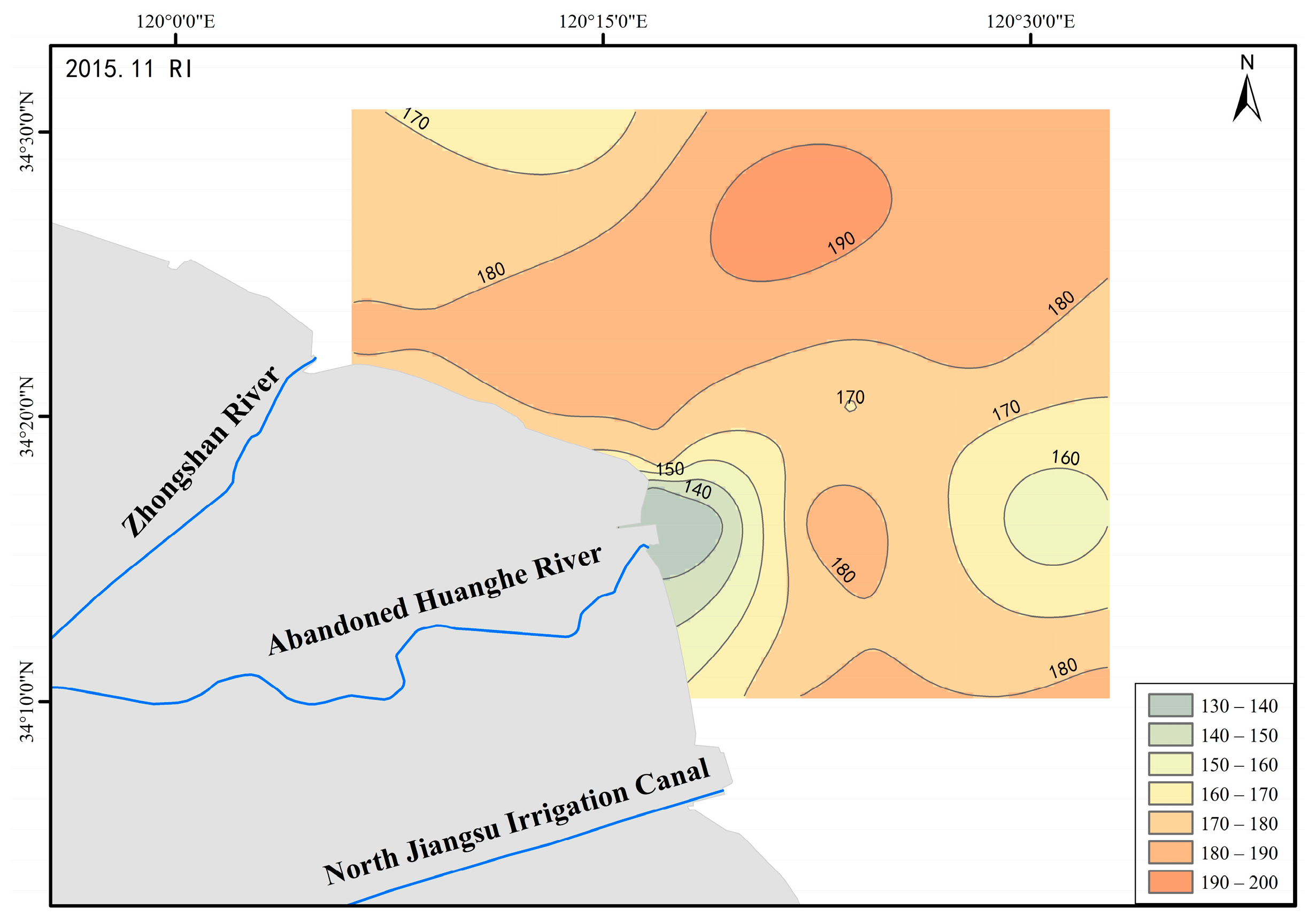
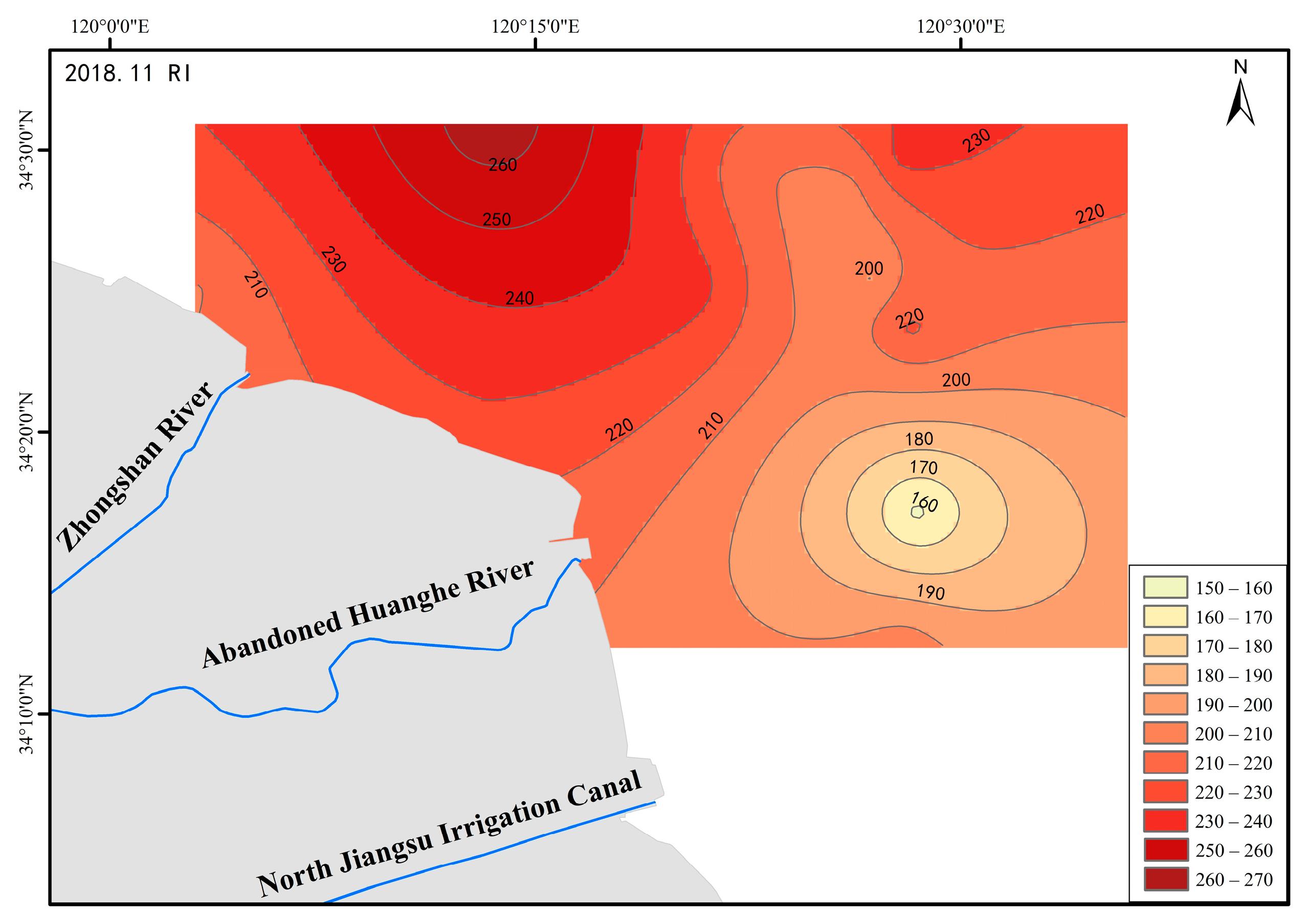


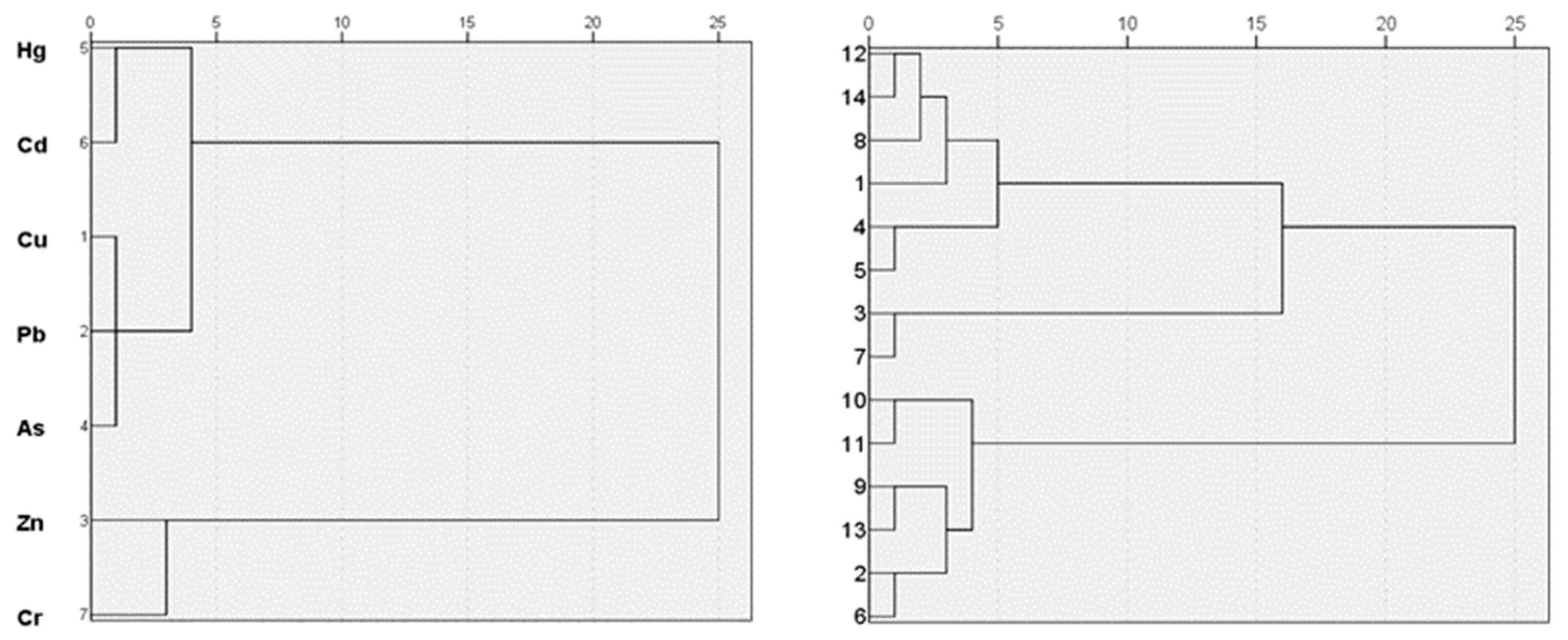
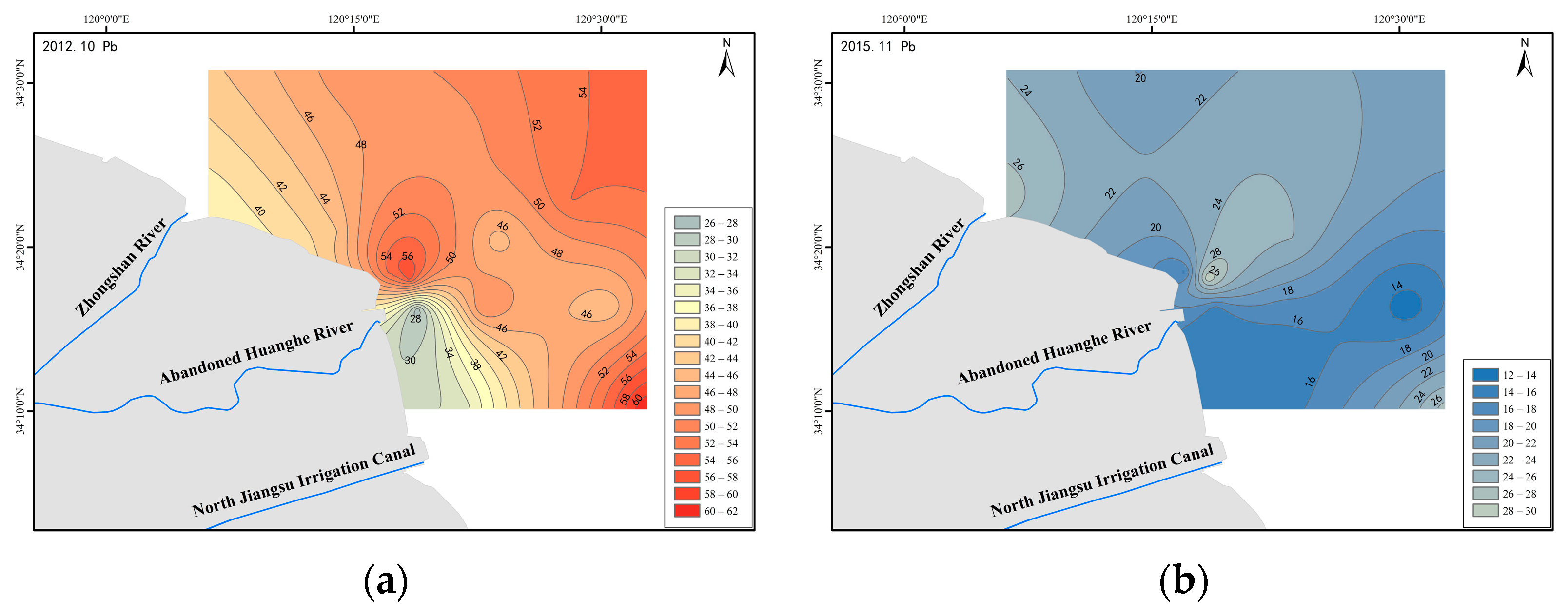
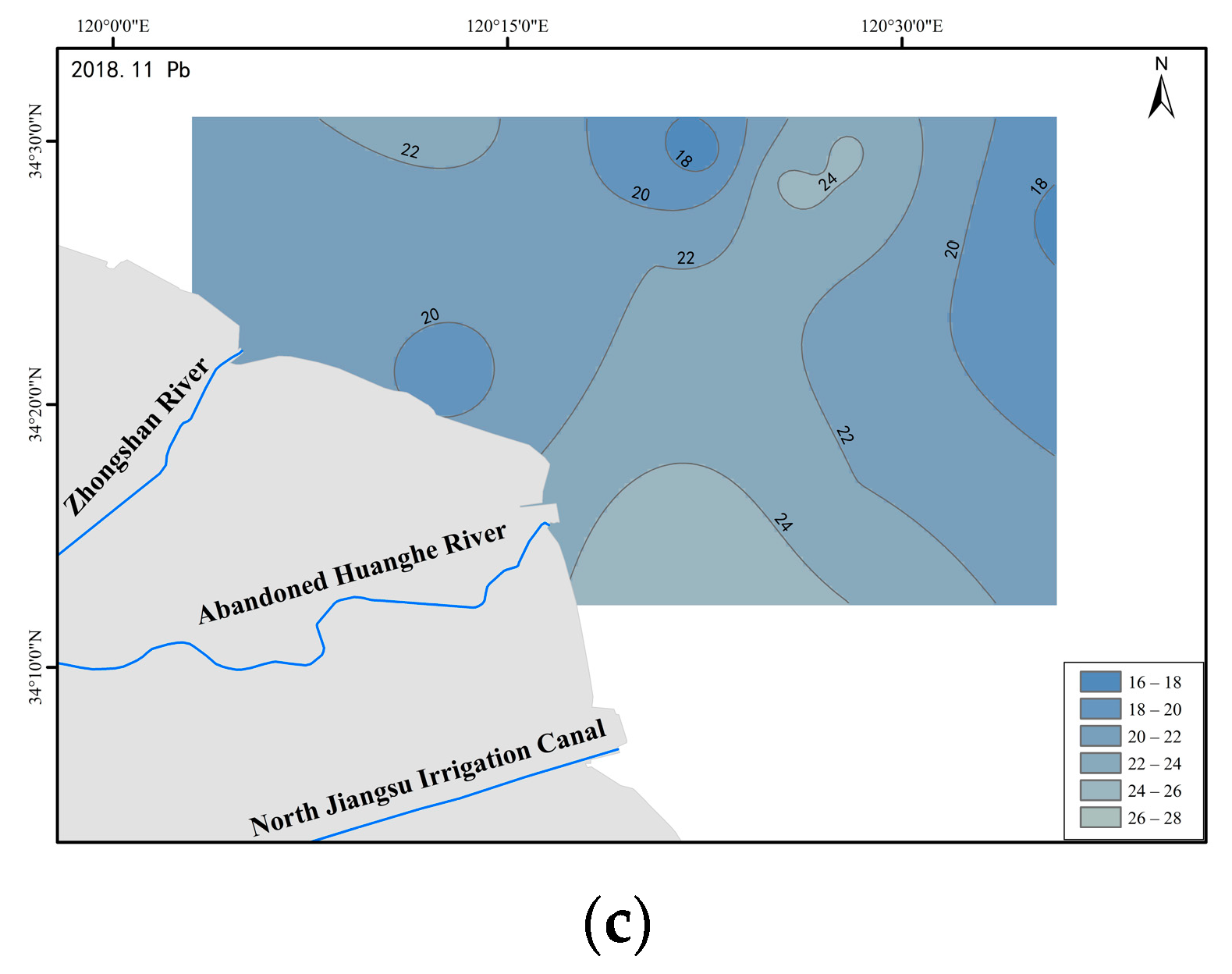
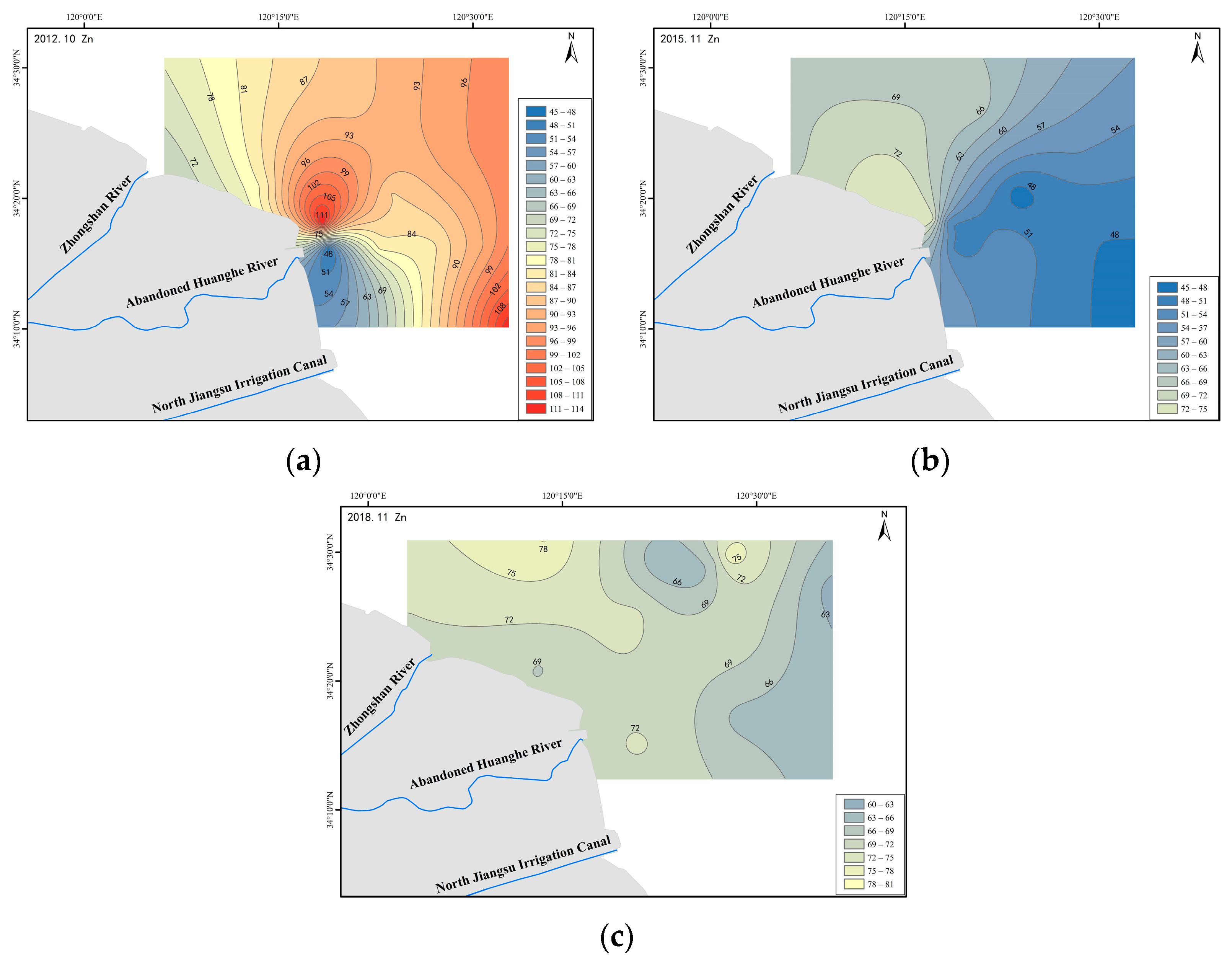
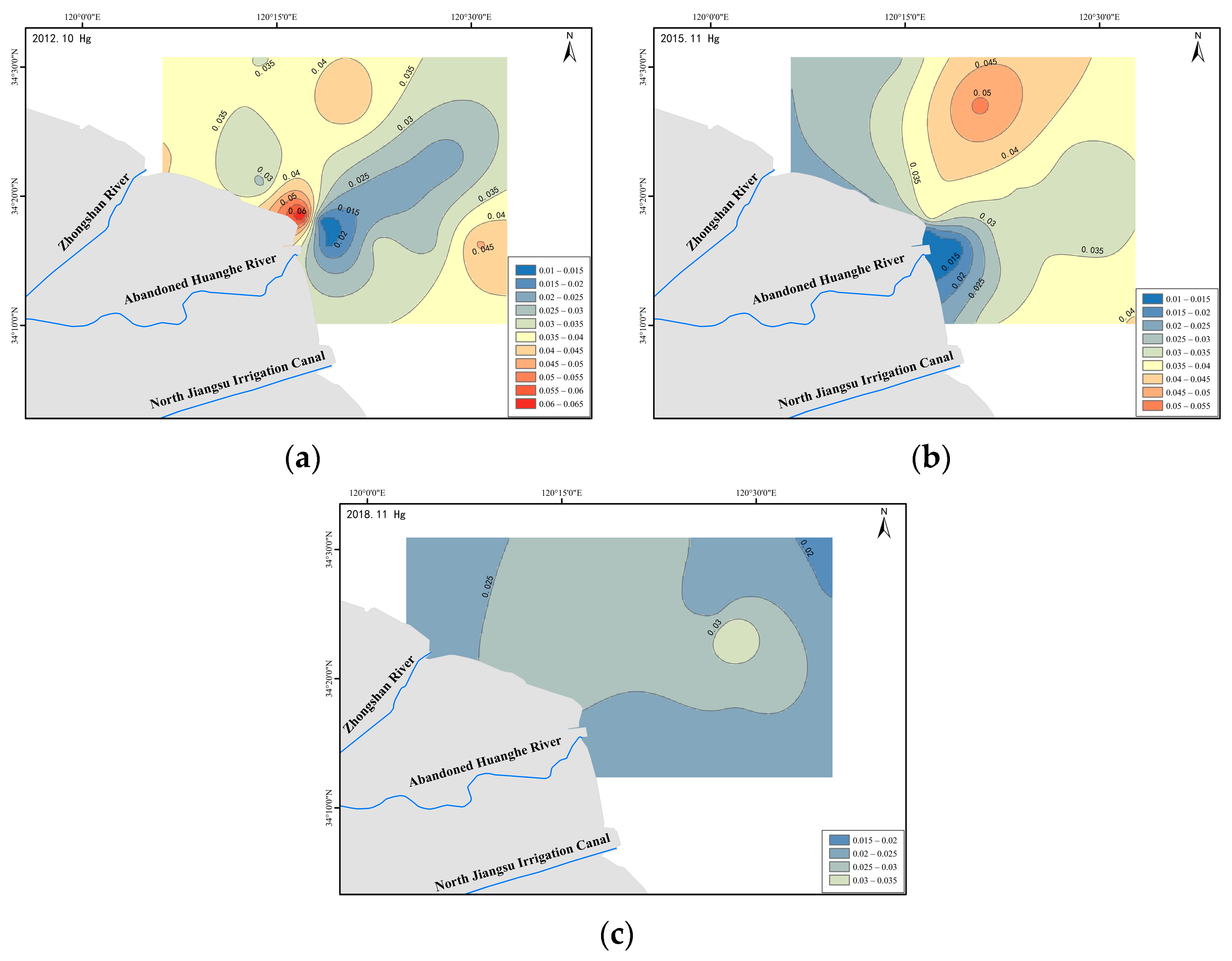
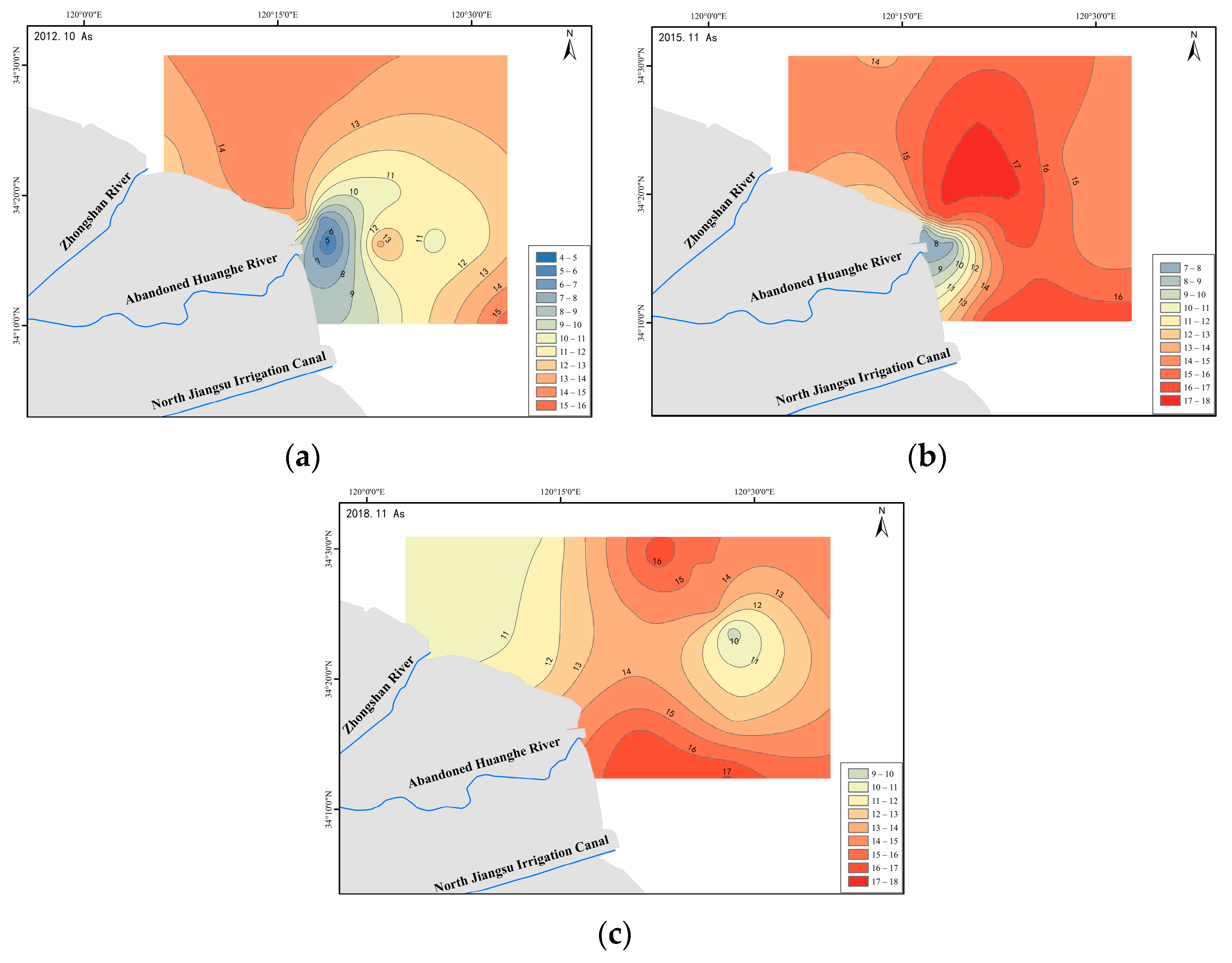
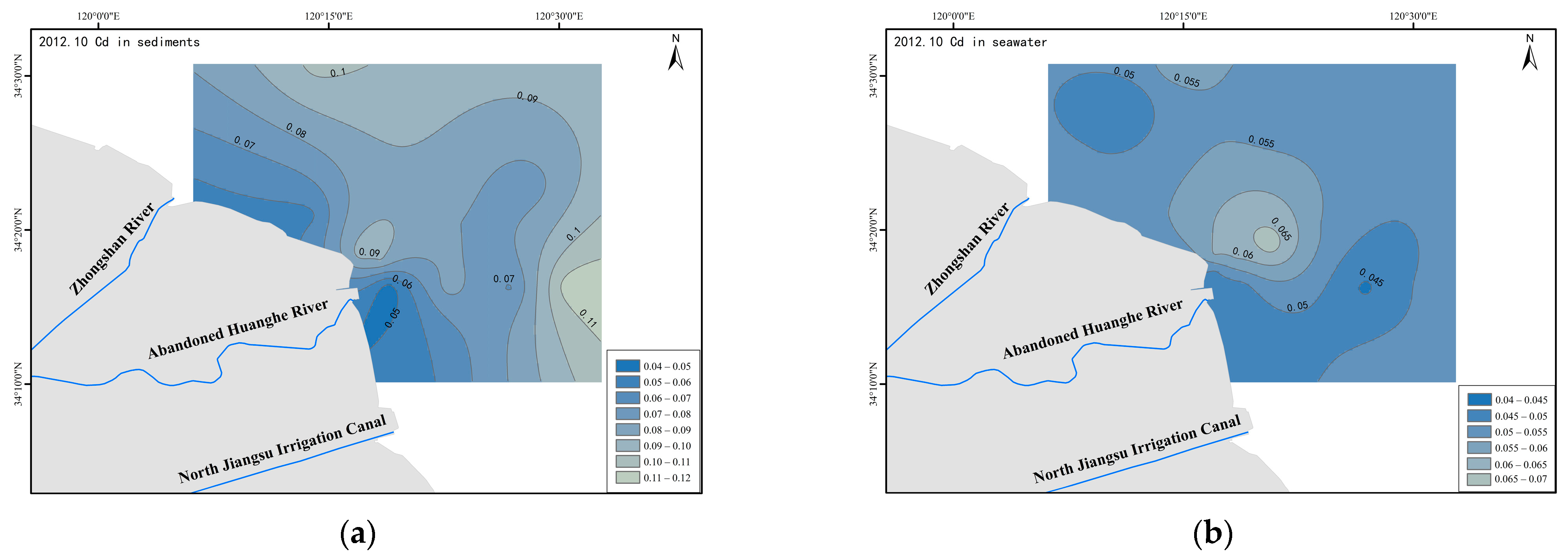

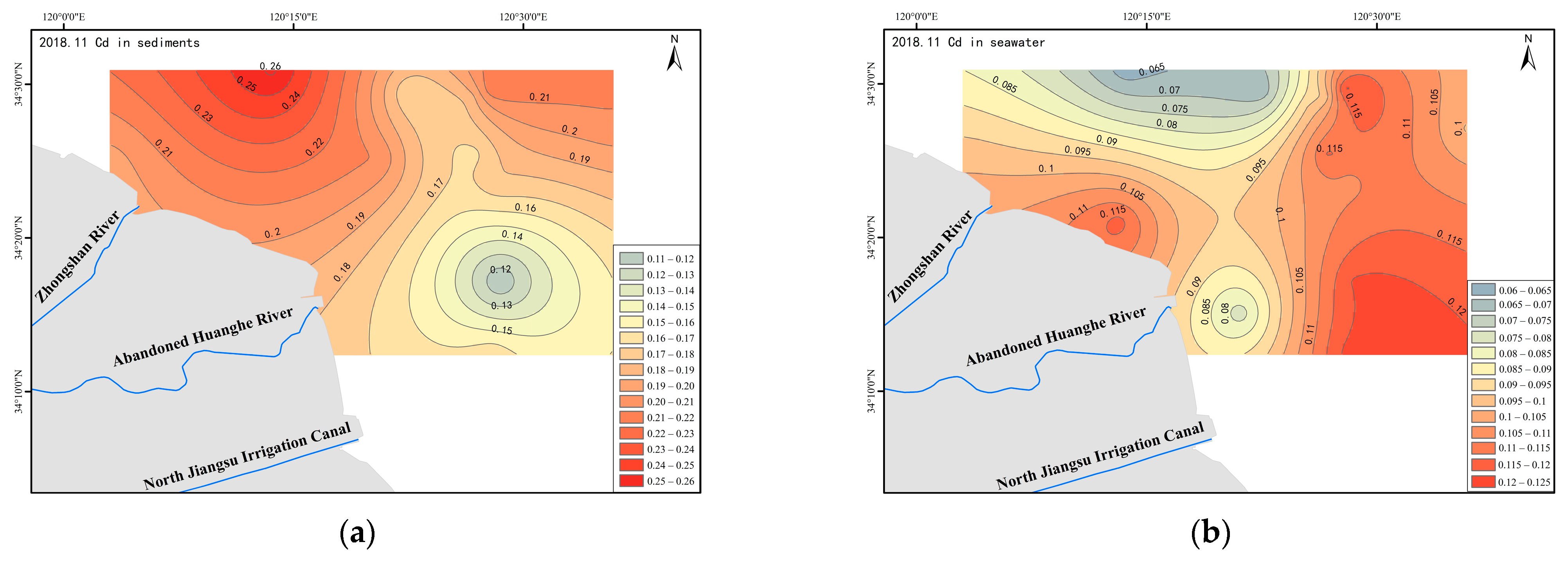
| Pollution Level | Risk Grade | Risk Grade | |||
|---|---|---|---|---|---|
| ≤0 | Clean | <40 | Low | <150 | Low |
| 0~1 | Mild | 40~80 | Medium | 150~300 | Medium |
| 1~2 | Mild–Medium | 80~160 | Medium–High | 300~600 | High |
| 2~3 | Medium | 160~320 | High | ≥600 | Extremely High |
| 3~4 | Medium–Heavy | ≥320 | Extremely High | ||
| 4~5 | Heavy | ||||
| >5 | Severe |
| Cu | Pb | Zn | As | Hg | Cd | Cr | ||
|---|---|---|---|---|---|---|---|---|
| Fall 2012 | Maximum | 36.1 | 61.8 | 114. | 15.5 | 0.0660 | 0.116 | 56.0 |
| Minimum | 9.62 | 27.0 | 46.7 | 4.94 | 0.0127 | 0.0439 | 29.9 | |
| Mean | 26.4 | 46.7 | 85.6 | 11.8 | 0.0332 | 0.0808 | 46.5 | |
| Fall 2015 | Maximum | 28.2 | 29.7 | 74.3 | 17.2 | 0.0516 | 0.140 | 58.6 |
| Minimum | 15.3 | 12.6 | 46.3 | 7.72 | 0.0112 | 0.0804 | 29.3 | |
| Mean | 19.7 | 20.4 | 58.8 | 14.4 | 0.0312 | 0.110 | 39.9 | |
| Fall 2018 | Maximum | 26.8 | 25.5 | 78.1 | 17.1 | 0.0344 | 0.262 | 56.6 |
| Minimum | 17.5 | 16.8 | 61.5 | 9.52 | 0.0192 | 0.110 | 35.3 | |
| Mean | 22.7 | 22.0 | 69.5 | 13.8 | 0.0246 | 0.187 | 44.3 | |
| Background values | 15.0 | 11.4 | 47.2 | 7.38 | 0.0230 | 0.0420 | 60.1 | |
| Cu | Pb | Zn | As | Hg | Cd | Cr | ||
|---|---|---|---|---|---|---|---|---|
| Fall 2012 | Maximum | 0.680 | 1.85 | 0.689 | 0.486 | 0.936 | 0.881 | −0.687 |
| Minimum | −1.23 | 0.659 | −0.599 | −1.16 | −1.44 | −0.521 | −1.59 | |
| Mean | 0.164 | 1.42 | 0.242 | 0.0283 | −0.181 | 0.309 | −0.973 | |
| Fall 2015 | Maximum | 0.324 | 0.796 | 0.0711 | 0.636 | 0.581 | 1.15 | −0.622 |
| Minimum | −0.558 | −0.441 | −0.611 | −0.520 | −1.62 | 0.352 | −1.62 | |
| Mean | −0.215 | 0.212 | −0.289 | 0.336 | −0.242 | 0.777 | −1.20 | |
| Fall 2018 | Maximum | 0.250 | 0.577 | 0.143 | 0.627 | 0.00419 | 2.06 | −0.672 |
| Minimum | −0.364 | −0.0255 | −0.202 | −0.218 | −0.845 | 0.804 | −1.35 | |
| Mean | 0.00196 | 0.352 | −0.0280 | 0.292 | −0.505 | 1.54 | −1.04 |
| Cu | Pb | Zn | As | Hg | Cd | Cr | RI | ||
|---|---|---|---|---|---|---|---|---|---|
| Fall 2012 | Maximum | 12.0 | 27.1 | 2.42 | 21.0 | 115 | 82.9 | 1.86 | 240 |
| Minimum | 3.20 | 11.8 | 0.990 | 6.69 | 22.1 | 31.4 | 0.995 | 81.1 | |
| Mean | 8.78 | 20.5 | 1.82 | 16.0 | 57.7 | 57.7 | 1.55 | 164 | |
| Fall 2015 | Maximum | 9.39 | 13.0 | 1.58 | 23.3 | 89.7 | 100. | 1.95 | 197 |
| Minimum | 5.09 | 5.53 | 0.982 | 10.5 | 19.5 | 57.4 | 0.975 | 131 | |
| Mean | 6.54 | 8.97 | 1.25 | 19.5 | 54.3 | 78.3 | 1.33 | 170 | |
| Fall 2018 | Maximum | 8.92 | 11.2 | 1.66 | 23.2 | 59.8 | 187. | 1.88 | 267 |
| Minimum | 5.83 | 7.37 | 1.30 | 12.9 | 33.4 | 78.6 | 1.17 | 158 | |
| Mean | 7.55 | 9.64 | 1.47 | 18.7 | 42.8 | 133 | 1.47 | 215 |
| Cu | Pb | Zn | As | Hg | Cd | |
|---|---|---|---|---|---|---|
| Pb | 0.847 ** | |||||
| Zn | 0.742 ** | 0.953 ** | ||||
| As | 0.789 ** | 0.500 | 0.371 | |||
| Hg | 0.541 * | 0.198 | 0.186 | 0.607 * | ||
| Cd | 0.648 * | 0.716 ** | 0.752 ** | 0.442 | 0.438 | |
| Cr | 0.141 | 0.429 | 0.368 | −0.247 | −0.428 | 0.150 |
| Cu | Pb | Zn | As | Hg | Cd | |
|---|---|---|---|---|---|---|
| Pb | 0.087 | |||||
| Zn | −0.487 | 0.011 | ||||
| As | 0.268 | 0.346 | −0.171 | |||
| Hg | 0.388 | 0.151 | −0.024 | 0.856 ** | ||
| Cd | −0.205 | −0.109 | 0.350 | −0.331 | −0.449 | |
| Cr | −0.254 | −0.140 | 0.273 | −0.644 * | −0.359 | 0.046 |
| Cu | Pb | Zn | As | Hg | Cd | |
|---|---|---|---|---|---|---|
| Pb | 0.399 | |||||
| Zn | 0.245 | 0.509 | ||||
| As | −0.148 | 0.190 | −0.359 | |||
| Hg | 0.171 | −0.357 | 0.075 | −0.382 | ||
| Cd | −0.238 | −0.058 | 0.569 * | −0.277 | −0.028 | |
| Cr | −0.562 * | −0.434 | 0.039 | 0.121 | 0.127 | 0.385 |
Publisher’s Note: MDPI stays neutral with regard to jurisdictional claims in published maps and institutional affiliations. |
© 2022 by the authors. Licensee MDPI, Basel, Switzerland. This article is an open access article distributed under the terms and conditions of the Creative Commons Attribution (CC BY) license (https://creativecommons.org/licenses/by/4.0/).
Share and Cite
Chen, S.; Xu, M.; Cui, D.; Lv, L.; Wang, Z.; Liu, B.; Wang, J. Distribution Characteristics and Ecological Risk Assessment of Heavy Metals in Marine Sediments of Binhai County, Jiangsu Province. J. Mar. Sci. Eng. 2022, 10, 1242. https://doi.org/10.3390/jmse10091242
Chen S, Xu M, Cui D, Lv L, Wang Z, Liu B, Wang J. Distribution Characteristics and Ecological Risk Assessment of Heavy Metals in Marine Sediments of Binhai County, Jiangsu Province. Journal of Marine Science and Engineering. 2022; 10(9):1242. https://doi.org/10.3390/jmse10091242
Chicago/Turabian StyleChen, Shu, Min Xu, Dandan Cui, Lin Lv, Zaifeng Wang, Baiqiong Liu, and Jing Wang. 2022. "Distribution Characteristics and Ecological Risk Assessment of Heavy Metals in Marine Sediments of Binhai County, Jiangsu Province" Journal of Marine Science and Engineering 10, no. 9: 1242. https://doi.org/10.3390/jmse10091242
APA StyleChen, S., Xu, M., Cui, D., Lv, L., Wang, Z., Liu, B., & Wang, J. (2022). Distribution Characteristics and Ecological Risk Assessment of Heavy Metals in Marine Sediments of Binhai County, Jiangsu Province. Journal of Marine Science and Engineering, 10(9), 1242. https://doi.org/10.3390/jmse10091242






